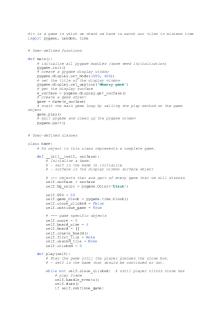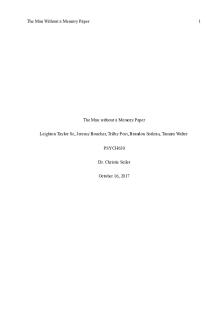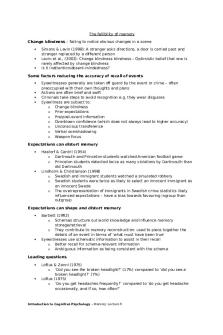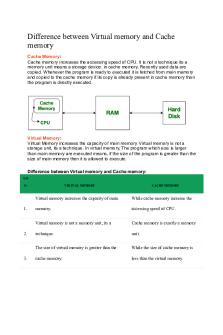Faulty Memory - Grade: A PDF

| Title | Faulty Memory - Grade: A |
|---|---|
| Course | Introduction To Psychology |
| Institution | Pace University |
| Pages | 5 |
| File Size | 79.6 KB |
| File Type | |
| Total Downloads | 85 |
| Total Views | 124 |
Summary
Faulty Memory Essay...
Description
Faulty Memory Lani Komatsu Dr. Jeannite 11/15/17 CRN 71321
People rely significantly on memory. It helps shape our behavior and how we see the
world. Memory is depended on in small ways one might not consider, such as: recognizing family members, remembering to eat, recalling your location, and much more. People deem memory more reliable than it is. A misconception about memories is that they are recorded and played back exactly as they happened, but in reality they are reconstructed from pieces of memories that are influenced by one’s perception and other factors that could impair the accuracy of encoding and recall. This contributes to false memories. This paper will evaluate one case study and two laboratory studies in relation to the reliability of memory, specifically when it comes to eye witness testimony. The case study involving Jennifer Thompson-Cannino and Ronald Cotton exemplifies how eyewitness testimony, which relies on memory, is not always dependable. In 1984, Jennifer Thompson-Cannino’s apartment was broken into and she was raped. Thompson-Cannino was 22 years old at the time attending college (Weir). She helped police make a sketch of her rapist which was later turned into a composite image (Weir). Thompson-Cannino identified Ronald Cotton in a photo lineup. Cotton was a 22-year-old man who looked very similar to the sketch Thompson-Cannino helped the police create. Cotton had a criminal record which further confirmed in Thompson-Cannino’s mind that he was her rapist (Weir). She then picked Cotton from a live lineup of similar and non similar looking men. Thompson-Cannino was convinced Cotton was the perpetrator. As a result, Cotton was convicted of rape and sentenced to life in prison. A decade later DNA testing became more prevalent, and Cotton used this to prove his innocence. The DNA test revealed that Cotton was not a match to DNA samples from Thompson-Cannino's assailant, but rather another convict: Bobby Poole (Weir). Poole admitted to a fellow inmate he had committed the crime. This case study exposes the life damaging effect(s) flawed memory can inflict on an individual's life when
1
it comes to convicting innocent individuals. Eyewitness misidentification has been the been the cause of 70% of wrongfully convicted individuals (Weir). This is grounds for a further look into the reliability of eyewitness testimony. The first laboratory study is Loftus and Palmer’s automobile crash reconstruction test performed in 1974. This test was to confirm the idea that memory is a reconstructive process. Loftus claimed that the nature (wording) of questions can influence a witness’s memory of an experience (Bookbinder). Leading questions – that is, questions that are suggestive in some way (hints) – and post-event information facilitate schema processing which may influence the accuracy of recall. Participants were shown 7 films of car accidents (5-30 seconds). After each clip participants were given a questionnaire asking: to give an account of the accident and how fast were the cars going when they smashed/collided/hit/bumped/contacted (Bookbinder). The change of the verb prompted different speed estimates. The more severe-sounding verb led the participants to give higher speed estimates. The verbs used in the various conditions activated slightly different schemas which influenced the speed estimates. Similarly, Loftus’ broken headlight experiment gauged the influence of an eyewitness’ testimony with the prompting from a leading question. This experiment used the same video of the car accident. The participants were split into two groups. One group was asked, “did you see a broken headlight?” versus the other being asked, “did you see the broken headlight?” The ‘the’ group had a higher percentage of people who claimed they had seen a broken headlight, when there wasn’t even one in the video (Bookbinder). If witnesses are asked questions that contain a false presupposition about an event, the false information may be incorporated into their memory —in this case, explicitly assuming a certain result of the event led to a direct alteration of witnesses’ memory (Bookbinder).
2
When determining how reliable these studies are in relation to the fragility of memory, some factors should be taken into consideration. Both automobile reconstruction tests lacked ecological validity in that they were conducted in a lab with specific conditions. In an actual automobile accident, other factors could distract and play a role in the inaccuracy of memory. Reports of real crimes are often given by the victims, not observers so the results of this experiment it cannot be directly applied to a real life situation. The unreliability of reconstructive memory (that can be influenced by incorrect/distortive schemas) and research by Loftus shows that memory is reliable to a small extent. However, due to the limitations and artificial nature of Loftus’ work, including the influence of demand characteristics, overall, memory is reliable to some extent. Eyewitness testimony can’t be completely discounted.
3
Work Cited Weir, K. (2016, February). Mistaken identity Is eyewitness identification more reliable than we think? Retrieved November 02, 2017, from http://www.apa.org/monitor/2016/02/mistaken-identity.aspx Bookbinder, S. H., & Brainerd, C. J. (2016). Emotion and false memory: The context–content paradox. Psychological Bulletin, 142(12), 1315-1351. doi:10.1037/bul0000077
4...
Similar Free PDFs

Faulty Memory - Grade: A
- 5 Pages

Flashbulb Memory - Grade: A
- 2 Pages

False Memory Lab - Grade: A
- 7 Pages

Memory essay - Grade: 1st
- 5 Pages

God's Faulty Heroes
- 20 Pages

Memory
- 3 Pages

Memory
- 5 Pages

A child - Grade: A
- 5 Pages

The Man Without A Memory Paper
- 5 Pages

Virtual Memory
- 58 Pages

CACHE MEMORY
- 1 Pages

Memory Psych
- 1 Pages

Virtual Memory
- 17 Pages

Memory notespack
- 16 Pages
Popular Institutions
- Tinajero National High School - Annex
- Politeknik Caltex Riau
- Yokohama City University
- SGT University
- University of Al-Qadisiyah
- Divine Word College of Vigan
- Techniek College Rotterdam
- Universidade de Santiago
- Universiti Teknologi MARA Cawangan Johor Kampus Pasir Gudang
- Poltekkes Kemenkes Yogyakarta
- Baguio City National High School
- Colegio san marcos
- preparatoria uno
- Centro de Bachillerato Tecnológico Industrial y de Servicios No. 107
- Dalian Maritime University
- Quang Trung Secondary School
- Colegio Tecnológico en Informática
- Corporación Regional de Educación Superior
- Grupo CEDVA
- Dar Al Uloom University
- Centro de Estudios Preuniversitarios de la Universidad Nacional de Ingeniería
- 上智大学
- Aakash International School, Nuna Majara
- San Felipe Neri Catholic School
- Kang Chiao International School - New Taipei City
- Misamis Occidental National High School
- Institución Educativa Escuela Normal Juan Ladrilleros
- Kolehiyo ng Pantukan
- Batanes State College
- Instituto Continental
- Sekolah Menengah Kejuruan Kesehatan Kaltara (Tarakan)
- Colegio de La Inmaculada Concepcion - Cebu

